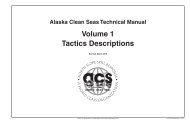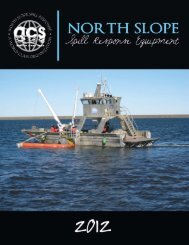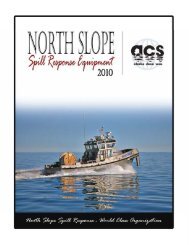Alaska Clean Seas
Alaska Clean Seas
Alaska Clean Seas
Create successful ePaper yourself
Turn your PDF publications into a flip-book with our unique Google optimized e-Paper software.
<strong>Alaska</strong> <strong>Clean</strong> <strong>Seas</strong>Training DepartmentPouch 340022Prudhoe Bay, AK 99734-0022Course Title: Advanced Oil Spill Response in IceDate: 31 JAN – 03 FEB 2012Location: CRREL Facility, Hanover, NHLength: 4 daysOverview:<strong>Alaska</strong> <strong>Clean</strong> <strong>Seas</strong> will use the CRREL Facility’s outdoor saline test basin for a four-day advanced icesafety and response course, scheduled for 31 JAN – 03 FEB 2012. Monday as a set up day for ACSinstructors and CRREL staff; the class days are Tuesday through Friday.Objectives:Using a classroom and field practical setting, at the completion of this training, students will be able toa) Demonstrate knowledge and proficiency in cold weather spill site safety tactics, ice safety, andrealistic cold weather operating limitationsb) Demonstrate knowledge and proficiency with oil spill response tactics for oil in and under icec) Demonstrate proficiency with spill response equipment including the Rube Witch, underwaterlight, ice profiling tools, GPSd) Integrate Ground Penetrating Radar (GPR) into field delineation activitiese) Conduct oil spill recovery operations in different ice conditions, including slush ice and broken icef) Plan and execute in-situ burning operations in broken iceFormat:Classroom: PowerPoint format with lecture and guided discussion presentations.Field Practical: Hands on Proficiency Checks with ACS equipment in the CRREL outdoor saline icebasin. Practical exercises in spill site safety, site set up, ice profiling, delineation, containment andrecovery tactics. Students will use Ground Penetrating Radar, GPS, and underwater lights as part of thedelineation exercise.Level:Intermediate to Advanced. All attendees should be familiar with response issues and equipment,HAZWOPER, and ICS. Paramount emphasis of this course will be Safety; ALL attendees must have andwear appropriate cold weather work clothing, including warm clothes, hard hat, safety glasses or goggles,hearing protection, gloves, warm safety toe boots and traction devices. (Warm winter boots may besubstituted for safety-toe boots at the discretion of the Safety Officer.) Students should bring air purifyingrespirators; the need for using them will be determined by air monitoring and site characterization. PFD’swill be required for ice profiling activities until ice thickness and stability has been determined, or asconditions warrant.Training Aids: ACS Technical Manuals; class handouts; NOAA Sea Ice Job Aids; ICS Forms 201, 214,ACS HSE Tailgate Forms; North Slope Site Safety Plan FormsEquipment: Rube Witch (chainsaw sled), underwater lights, small portable skimmers and power pack,rope mop skimmer, ice augers, ice profiling electric drill with bits and flights, cold weather field supportequipment and heated shelters, handheld GPS units, GPR equipment, in-situ burning igniters, airmonitoring equipment2012 ACS / CRREL Advance Ice Safety and Response Training Course Page 1
<strong>Alaska</strong> <strong>Clean</strong> <strong>Seas</strong>Oil Response in Ice Training CourseCold Regions Research & Engineering Laboratory (CRREL)Engineer Research & Development Center (ERDC)Hanover, NHDate: 30 JAN – 03 FEB 2012Day 030 JAN 2012 (at CRREL Facility)0800 Site prep and setup Classroom setup Snow removal and site clearing Move powered equipment to warm storageand perform PMsDay 131 JAN 2012 (at CRREL Facility)0800 Introductions & Course Objectives Course Description, Agenda, Expectations Overview of CRREL and ERDC Facilities0900 Sea Ice and Freshwater Ice Characteristics NOAA Sea Ice Job Aids1000 Cold Weather Spill Site Safety Site Safety Plan Ice Safety and Ice ProfilingField Practical: Site Clearing and Setup Decontamination Setup Warm-Up Area and Warm Storage Setup Atmospheric Testing Ice Profiling Tactic1200 Lunch1300 Surveillance & DelineationField Practical: Delineation of Oil Under Iceo Underwater Lighto Ground Penetrating Radar Survey Mapping and Surveillance of a Spill on Lando Garmin GPSMAP-60 CSx or 76CSx1700 SecureClassroom& FieldClassroomClassroomClassroomS-2Tactic:S-4, L-2S-6L-2S-5L-7Tactic:T-1, T-3T-2ACS Training,Operations Support,Mechanic, andCRREL StaffClassroom:PowerPoint andhandoutsClassroom:PowerPoint andhandoutsField:Warm-up sheltersetup; site layout andfield setup, airmonitors, electricdrills; Ice augersField:Handheld GPS, iceaugers, underwaterlight, small generator2012 ACS / CRREL Advance Ice Safety and Response Training Course Page 2
Day 403 FEB 2012 (at CRREL Facility)0800 Review of Day 2 and Day 3; Briefing and FieldAssignments.0830 Containment and Recovery in Slush Ice, Forming Iceand Broken Ice Skimmers in slush and broken ice Burning Tactics for land, ice and broken iceconditions0900 Burning Tactics for Oil in Broken Ice Containment in Broken Ice Use of Igniters Recovery of burn residue1200 Lunch1300 Critiques, Final Comments, EndClassroomClassroomR-31B-3, B-5B-3, B-5,B-6Classroom:PowerPoint andhandoutsField:Oil Ignition SystemFacility OverviewTraining course will utilize classroom and outdoor saline ice basin.Tank is 60 x 25 x 7 feet deep with a removable roof and refrigeration system to maintainthe ice conditions. CRREL will grow 2 feet of sea ice in the tank. North Slope Crude Oilwill be injected under the ice and into the ice as it is forming.A rail-mounted gantry runs the length of the tank and can be rigged with pulleys andattachment points to raise and lower skimmers if necessary. Additional rail-mountedwork platforms are available if ice becomes unsafe to walk on.Deck space at the end of the tank approximately 20 x 25 feet, plus additional clear groundalong east side of tank (approximately 80 x 15 feet) that is available for decontamination,WeatherPORT shelters, and equipment lay down area.Figure 1 on next page: View looking north, with concrete platform at far end of tank, andremovable roof rolled out of the way. Proposed layout of 2012 ACS Training Course overlaidon picture. Current plan is to use ½ of the tank area for initial ice cuts. Second half of tank willbe used for additional slots or for vendors’ equipment as needed.2012 ACS / CRREL Advance Ice Safety and Response Training Course Page 4
2012 ACS / CRREL Advance Ice Safety and Response Training Course Page 5






